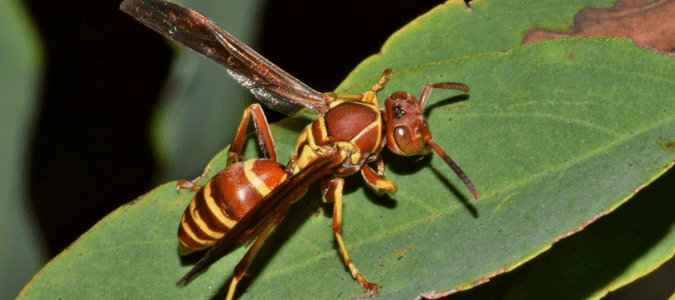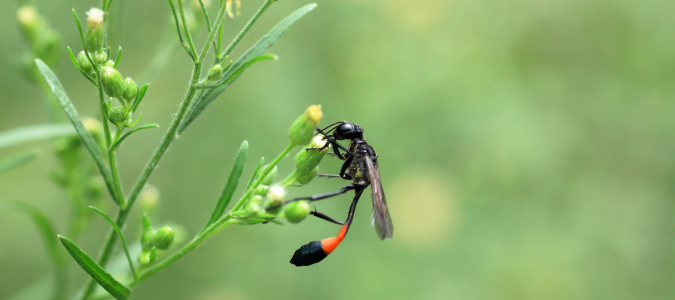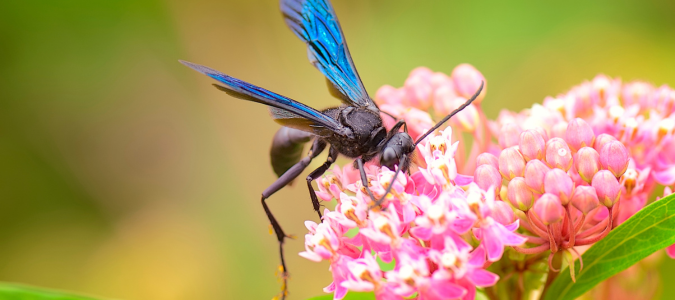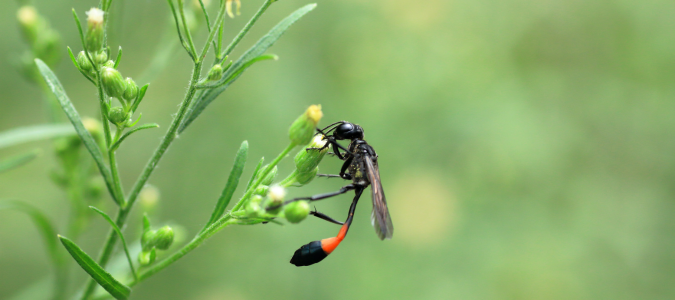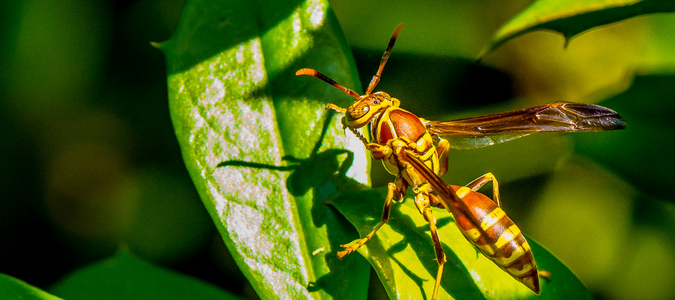Wasps don’t have the same kind of notoriety as other pests like rats and cockroaches. But that doesn’t mean they can’t cause us harm and annoyance. Unlike bees, which only sting once, wasps can sting several times. Their stings are painful and can cause the area near the sting to swell.
Wasps sting humans when they feel like you’re invading their territory. You don’t want that kind of hostility on your property. Here’s everything you need to know about these pests so you can stay vigilant. However, it’s best to leave these pests to the pest control professionals. They’ll control the wasps for you.
How Do Wasps Make Nests? Here’s Everything You Should Know
While no one wants to see wasp nests on their property, they are interesting to look at. Intricate and delicate, you can tell how much work wasps put into them. So, how do wasps make nests? It all starts with the queen. She’ll come out of hibernation in the spring and get to work.
First, she’ll scout for the perfect spot. It can be a cozy hole in a tree or a hidden crack in a wall. Watch out because she might target your attic, roof eaves or the space under your house. After deciding on a nesting site, the queen will source wood fibers from logs, trees and cardboard. She’ll chew them up, mixing them with her saliva to create a thin, paper-like material. That will be the foundation of her new home.
Like a skilled architect, the queen will work on the outer walls first and then build the inner hexagonal cells. She’ll then lay eggs inside these compartments. Then, her colony begins. Soon, larvae will emerge from these eggs and grow into adult wasps. The queen’s work doesn’t stop there. She’ll continue laying eggs until her colony reaches its full size in the summer. The grown wasps will keep expanding the nest to accommodate the new members.
Hornets, yellowjackets and paper wasps are some of the most common types of wasps. While they all make nests, the size, shape and location of these can vary. Hornets don’t like cramped spaces. They build massive football-shaped nests, often dangling from a lofty tree branch. On the other hand, yellowjackets prefer concealment, building their nests underground. As for paper wasps, they like the coziness of a tiny home. You can usually spot their small umbrella-shaped nests hanging from eaves.
While wasp nests are interesting, you don’t want them on your property. Contact pest control experts if you see any around your home. They know how to get rid of wasps.
What to Do When You See a Small Black Wasp in the House
Seeing a creepy crawly inside the house can send homeowners into a panic. But we can’t blame you if it’s a wasp. These insects can sting multiple people several times, so it’s understandable why people are scared of them. If a black wasp enters your home, it’s probably a cricket hunter or a mud dauber. Here’s what you should know about these two pests:
Cricket Hunters
Cricket hunter is an odd name for wasps, but there’s a reason for it. These wasps love to catch crickets and make a tasty meal out of them for their babies. They’re outdoor insects that can sometimes become household pests. You’ll likely see these unwelcome guests in your home during late summer and fall. Cricket hunter infestations are persistent and require the expertise of a pest control specialist.
Cricket hunters are matte black with gray wings. They’re not too big, usually about one-half inch in length. They typically capture crickets and haul them back to their nest. So why do they sometimes make their way indoors? In their natural habitat, female cricket hunters build their nests underground. But in urban areas where they can’t find suitable nesting sites, they depend on artificial structures. The cracks and crevices on the outer framework of our homes are ideal breeding grounds for them.
After catching a cricket, the female cricket hunter will place the cricket inside the wall cavity they found. They’ll then top the cricket off with an egg. When the egg hatches, the paralyzed cricket is an instant buffet for the baby. Other females can lay their eggs in the same nesting site. Once the babies develop into adults, they can use wall openings, air vents and window gaps to invade your home.
When female cricket hunters place their cricket stashes and eggs inside your walls, there’s no stopping the babies from taking over your indoor space. The best solution is to block off any possible entryways you see around your home. But if it’s too late and they’re already inside, let pest control experts take over. They’ll control the wasps around your property and seal entry points to prevent future infestations.
Mud Daubers
Mud daubers may sport various looks, but they’re usually black, have dark wings and are one-half to an inch long. Their bodies might have light markings or a blue metallic sheen to them. They’re slender insects with a thread-like waist, making them easy to tell apart from cricket hunters.
Mud daubers construct their nests with mud, which explains their name. They’re intelligent wasps, building their nesting sites in protected areas like sheds, garages and attics. Their nests look like little tubes, usually only an inch long, and are side by side. If you see these around your property, you might have an infestation on your hands.
Before you panic, mud daubers are pretty harmless. They’re not aggressive and don’t feel the need to defend their nests from intruders. They’re more annoying than harmful. Some people may even consider them beneficial because they feast on spiders, including the nasty black widow spider. But that doesn’t mean you shouldn’t be careful. When mud daubers vacate their nests, other more hostile wasp species can take over.
If you want a home free of mud daubers, take the time to seal off any cracks, holes and gaps you see. That will decrease the prey population and keep these pests from getting comfortable in your living space. If there are already existing nests inside your house, let the professionals handle the problem. Pest control specialists will remove the mud structures and take steps so the mud daubers don’t return.
Will Wasps Return to a Destroyed Nest?
A wasp colony will never return to a nest they’ve previously abandoned. But, that doesn’t mean a new colony can’t come and take over. Even if it’s just remnants of a nest, they can rebuild it. That’s why it’s crucial to remove these hideouts. Making your property unattractive to wasps is important so they don’t build nests in the first place. Here are some tips that can deter these pests.
Prioritize Cleanliness
Wasps are food lovers. Whether sugar or protein, they’ll make a feast out of it. Make cleanliness a priority to keep these pests from coming to your house. Throw out any food scraps that may be lying around in your yard.
Also, clean your grill thoroughly, ensuring there are no food bits stuck to it. If you recycle soda cans, wash them out before storing them in a bin. Trash cans are another delicious food source for wasps. If you don’t seal them well, these pests might build their nests nearby.
Block Off Openings
Pests take advantage of cracks, holes and gaps in structures to break in. Wasps are no different. Inspect your home for possible entry points and seal them off. Look out for hollow spots in the ground, crevices on walls and wire entryways. Plug them up with a suitable sealant like cement, caulk or steel wool. The best season to do this is in the fall before wasps build their nests in the spring.
No matter how unwelcome you make wasps feel, they might still take a liking to your property and build a nest there. If that’s the case, let pest control specialists solve the problem. They’ll free your home of these troublesome pests so you can feel safe and comfortable again. They can also help you learn more about their behavior, like whether wasps are active at night.
Dealing With a Wasp Infestation? Let the Professionals Help
Maintaining a home is hard enough. A wasp infestation on top of everything is stressful for any homeowner. If wasps are making you crazy, pest control experts can come to your rescue. They know how to restore the peace in your home and keep these pests from wreaking havoc.
ABC Can Treat the Wasps on Your Property
Having wasps on your property can be frightening. Instead of trying to handle the problem on your own, contact ABC Home & Commercial Services. Our pest control professionals can offer advice on what attracts wasps, and we can effectively remove any wasps, including paper wasps, so you don’t have to worry about painful stings.
